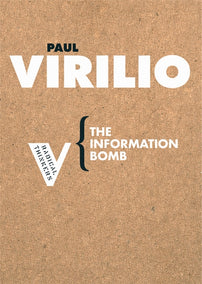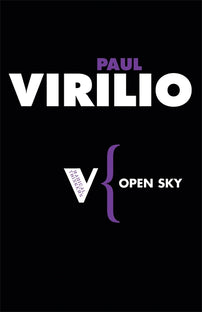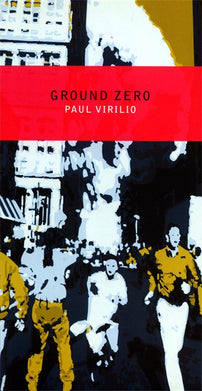Open Sky
Paul Virilio, who died on the 10th September, was one of France's most celebrated cultural theorists.
In this, the introduction to Open Sky, Virilio explores the social destruction wrought by modern technologies and critiques the breakdown of our collective and individual relation to time, space and movement in the context of global electronic media.

The blue sky above us is the optical layer of the atmosphere, the great lens of the terrestrial globe, its brilliant retina.
From ultra-marine, beyond the sea, to ultra-sky, the horizon divides opacity from transparency. It is just one small step from earth matter to space-light - a leap or a take-off able to free us for a moment from gravity.
But the horizon, the skyline, is not only a launch pad. It is also the very first littoral, a vertical littoral, the one which absolutely separates 'the void' from 'the full'. Unremarked invention of the art of painting and of distinguishing a 'form' from a 'background', the groundline anticipates from afar the maritime shore - the 'Azure Coast', that horizontal seaboard that so often causes us to lose sight of the zenithal perspective.
Besides, the entire history of Quattrocento perspectives is only ever a story of struggle,of the battle of geometers vying to make us forget the 'high' and the 'low' by pushing the 'near' and the 'far', a vanishing-point that literally fascinated them, even though our vision is actually determined by our weight and oriented by the pull of earth's gravity, by the classic distinction between zenith and nadir.
The original reference point for sight is therefore not what the Italian masters said it was, that of vanishing lines converging on the horizon, but one bound up with the delicate balancing act of a universal attraction which imposes on us its gearing towards the centre of the Earth, at the risk of ourfalling.
As Victor Hugo put it: The rope doesn't hang, the Earth pulls.
In this age of the sudden pollution of the atmosphere, it is about time we revised our perception of appearances. To raise your eyes to the heavens could become more than a sign of helplessness or exasperation.
A secret perspective is, in fact, hidden on high.
A different kind of vanishing act from that performed by the ozone is hidden behind the clouds. The breakaway of the Wright brothers on their first take-off from the beach at Kitty Hawk or, perhaps, the liftoff of the Apollo 11 mission at Cape Canaveral, show us another way, an exotic reorganization of sight that would finally take account of a possible fall upwards brought on by the recent acquisition of the speed of liberation from gravity: orbital speed at 28,000 kilo metres perhour.
Preoccupied as we are, at the end of the millennium, with developing the absolute speed of our modern real-time transmission tools, we too often forget the comparable historic importance of this other limit-speed, the one which has enabled us to escape the real space of our planet and so to 'fall upwards'.
Reverse vertigo that may well force us to change the way we think about the landscape and about the human environment.
So not only has our generation just discovered a hole in the thin layer of ozone that once protected us from cosmic rays; it has also just poked another one in the blue, for, from now on, our sky is vanishing. The vanishing-point at the horizon of the Quattrocento is now coupled with that of the Novecento: today, there is a way out up above. An artificial counter-gravity allowing man to shed telluric gravity, the stability of gravitational space that has always oriented man's habitual activities.
Everything is being turned on its head at this fin desiecle - not only geopolitical boundaries but those of perspective geometry.
Arse over heels! Appearances generally and those of art in particular are being deconstructed - but so is the sudden transparency of the world's landscape.
Soon we will have to learn to fly, to swim in the ether.
If we really want to reorient our daily lives, we will soon need to change our bearings, to shift our sights 'upwards'.
If the loss of the inaccessible far reaches is accompanied by a media proximity that owes everything to the speed of light, we shall also pretty soon have to get used to the distortion of appearances caused by the real-time perspective of telecommunications, a perspective in which the old line of the horizon curls itself inside the frame of the screen, optoelectronics supplanting the optics of our telescopes!
And this is all in preparation for astrophysics' great surprise: beyond earths pull, there is no space worthy of the name, but only time! A kind of time that will take on cosmic reality single-handed.
Indeed, have not certain astronomers and mathematicians recently asserted that time has its own inertia, that time is in fact matter, a dif ferent kind of material? 1
Once astrophysicists stop talking exclusively about 'space-time' and start talking about 'space-time-matter', they help to lock extension and duration into the web of a different kind of cosmic materiality, unrelated to our experience of the trinity of matter, space and time. 2
By the same token introducing a third kind of interval of the 'light' type alongside those of 'space' and 'time', they engineer the emergence of a new conception of time, which is no longer exclusively the time of classic chronological succession, but now a time of (chronoscopic) exposure of the duration of events at the speed of light - something certain writers interested in police investigation methods long ago divined. Indeed if, according to Emile Gaboriau's sleuth, 'time is just one more obscurity' that gradually wipes out all the clues and winds up concealing the truth of the facts, then speed is time's light, its sole 'light' and one can no longer consider duration - any duration or any physical extension - without the help of the illumination of an absolute speed that changes our understanding of time.
To the passing time of the longest durations,we now add accordingly a time that is exposed instantaneously: the time of the shortest durations in the realms of electromagnetism and of gravity.
It is easy to imagine the havoc wreaked by this new 'conception of the world', its effects on the very nature of perspective and so on the orientation of human activities: if time is matter, what is space?
These days it is not the 'geographic' space of the golden hills of Tuscany under the Italian Renaissance sun, a 'geometric' space that once shaped a durable vision of the near world through the window of perspective. It is now the space over the seas and beyond the sky, this so-called 'cosmic space' whose obscurity is no longer so much a matter of lack of sun as of the night of a spaceless time without measurable extent apart from seasonless 'light-years', since alternation of night and day is now saddled with an alternation of terrestrial space and its extraterrestrial absence.
So the temporal day of our matter-years will be joined by a night of spaceless light-years, the obscure reign of an absent mass that will finally be identified with universal time, that is to say, with an otherworldly temporality bearing no relation to the fundamentally 'spatio-temporal' nature of our activities within the space of a planet suspended in time; the ether of 'time-light' being in no way analogous to our usual calculation of duration and geophysical span.
Listen to the physicists specializing in this famous absent mass: 'What are these particles that form the dark mass, the substantial non-lumi nous part of the Universe? It is tempting to assume that the dark rings of the galaxies are made of supernatant baryons. These baryons would be found in the compact form of small dark stars - brown dwarfs - but such celestial objects can only make up a small part of the dark matter of theUniverse.' 3
The 'rest' of this cosmic darkness, so vast that it defies the scientific imagination, would then be the absent mass of time, would it not? This cosmic time that escapes our astronomic observation, in also escaping the absolute but finite speed of light? Universal tem porality that remains in 'the shadow' of an acceleration limited to 300,000 kilometres a second.
In such hypothetical conditions, contemporary research into the famous big bang might be said to be an illusion, an optical illusion of cosmology!
How can we hope to contemplate live - thanks to Indra, the new machine of the great national heavy ion accelerator - the creation of space-time-matter fifteen billion years ago, if the inertia of universal time screens out all observation due to the very finite nature of the speed of light, of this time-light that illuminates events, while being at the same time quite incapable of illuminating itself?
Besides, in baptizing a technological device designed to pick up the very first sign also of the universe Indra, from the name of theVedic god of the heavens, our scientific elders overlooked the discontinuity that apparently exists between space-time subject to earth's gravity and the space-time of the extraterrestrial other world.
After 'anthropocentrism' and 'geocentrism', our contemporary savants seem now to be in the grip of a new kind of illuminism, or rather luminocentrism, capable of hoodwinking them about the profound nature of space and of time, the old perspective of the real space of the Quattrocento once again blocking the perspective of the real time of a horizonless cosmos.
But to conclude this eminently probabilist introduction, we might return to our new 'cote d'Azur', to this zenithal shore that so clearly partitions off the sphere of a space-matter subject to earth's gravity from the extraterrestrial time-light whose depth dissimulates the very density of time, the dark mass of universal time ultimately giving the optical layer of our planet its azure colour.
If nature abhors a vacuum,so too does la grandeur-nature (life-size). Without weight or measure, there is no 'nature' any more or, at least, no idea of nature. Without a distant horizon, there is no longer any possibility of glimpsing reality; we drop into the time of a fall akin to that of the fallen angels and the earth's horizon then becomes just another 'Baie des Anges'. Philosophical let-down in which the idea of nature of the Age of Enlightenment is eradicated, along with the idea of the real in the age of the speed of light.
1 See the theory published jointly in 1991 by Professor R.J. Taylor of Sussex University and Professor Alexander Abian of the Mathematics Department of Iowa University.
2 G. Cohen-Tannoudji and M. Spiro, La Matiere-espace-temps, Paris 1986.
3 Les Chemins de la science (a text based on the findings of general report compiled by the Centre national de la recherche scientifique), Paris 1992, p. 9
[book-strip index="1" style="display"]

